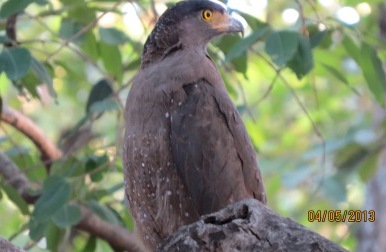The road from Ambadi to Shirsad forms part of the highway connecting Mumbai to Ahmedabad. From Shirsad, a smaller road connects to the Nasik-Mumbai highway. For about 20 kilometers between Shirsad and Ambadi, the road is covered with a green canopy of over 300 gulmohur, mango, rain-trees and banyan trees. Motorists traveling along the road are truly privileged and never fail to appreciate the far-sighted vision of unknown road engineers (or foresters) responsible for it. Over a period of time, these trees have grown bigger and stronger, some of them with a girth of more than one hundred centimeters, providing shade and shelter to all wild creatures and mere mortals like us. But with time, as traffic along the route increased many fold, there arose a need to widen the road from the present two lanes to a four-laned carriageway.
Trees - first targets of road widening
As it usually happens in India, the responsibility must have been assigned to some city-based bureaucrat, who proposed that the widening be done on the existing alignment. In other words, the trees would have to make way for tar or concrete road laid by the Vasai-Virar Municipal Corporation. A more short-sighted proposal would be harder for even primary school children to come up with. Trees lining the roads are always the first targets for any road widening projects in India. We have seen this all over the country, including projects undertaken for metro-rail/mono-rail construction. Encroachments and illegal constructions, very often belonging to the political class and local land mafia, are most conveniently spared the stick (I mean the earth-movers). In many instances, the mafia working hand-in-glove with corrupt officials or talathis, construct a small religious structure (temple, mosque, cross) overnight, which makes it next to impossible to demolish them. Even if they are demolished by some upright official, she/he would face the combined forces of the political class and be forced on the backfoot. Look at what has happened to Durga.
Land of Gods?
In the land of Rama, Krishna, Allah, Jesus and the Buddha, the politicians have become all powerful forces, fearing neither Gods nor the rule of the law. I am reminded of the song by Indian Ocean: Zara rukh ja re bandhe, zara tham ja re bandhe….(from the movie Black Friday, it can be loosely translated as: Oh brother, stop breaking the law and fear the Lord!)
Trees, without any political protection are ruthlessly hacked down, leading to loss of habitat for our feathered friends. Irreparable damage is done to the soil and the surrounding micro-environment. Presence of trees acts like a natural sieve, allowing rain water to seep into the ground, recharging natural aquifiers and increasing ground water table. Trees also prevent excessive evaporation of moisture from the soil surface, an important factor in maintaining soil quality in hot and dry climatic conditions.
Native species - a better choice
A significant point to be considered is that native tree species are better suited in ensuring soil stability than non-native or foreign species. Hence, deforestation cannot be compensated by planting non-native species, like subabul or eucalyptus. Experts have opined that reckless replacement of pine trees with golden oaks/silver oaks has been a major cause for the recent landslides and soil erosion in Uttarakhand. Pine needles form a thick bed on the forest floor allowing water seepage, preventing erosion and loss of topsoil.
Well, environmentalists, relax! The good news in the paper yesterday (TOI, 03.08.2013) is that the local development authority, MMRDA, has issued a stop-work notice to the Vasai-Virar Corporation and the permission to cut trees withdrawn. A new alignment has been proposed for four-laning the road – certainly a small victory for the green brigade and hopefully one of many more to come.
Go green, save paper, save our trees





